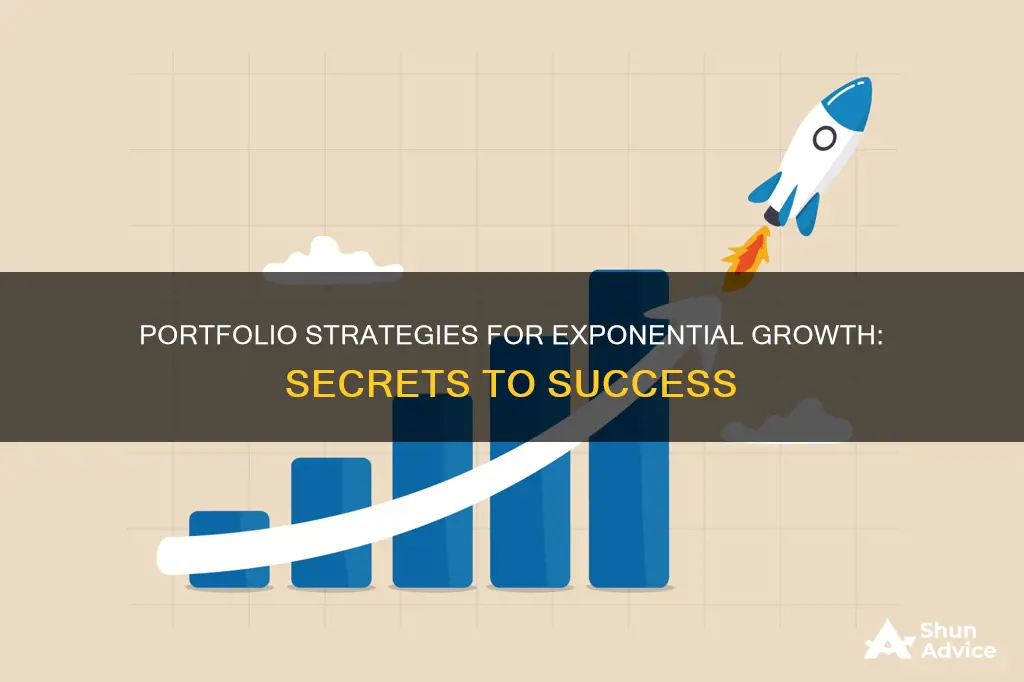
Exponential growth is a powerful concept in finance and investing, where it is often referred to as compound growth or compounding. It refers to a pattern of data that shows greater increases over time, creating a curve on a graph that starts slowly and then accelerates swiftly. In the context of an investment portfolio, exponential growth means that investors benefit from larger growth over longer periods, allowing them to create large sums with little initial capital. This is achieved through compounding, where investors earn interest on the additional earnings received from previous interest payments, as opposed to simple interest, which only pays interest on the original principal. Exponential growth in investment portfolios can be seen in various investment instruments, including stocks and high-interest savings accounts.
| Characteristics | Values |
|---|---|
| Definition | Exponential growth is a pattern of data that shows greater increases over time, creating an upward curve of an exponential function. |
| Formula | The formula for exponential growth is V = S x (1+R)^T, where S is the starting value, R is the interest rate, T is the number of periods that have elapsed, and V is the current value. |
| Examples | Common examples of exponential growth include the growth of cells, the returns from compounding interest from an investment, and the spread of a disease during a pandemic. |
| Comparison to Linear Growth | Linear growth happens at the same rate of change, whereas exponential growth has a constant multiplier, so the growth rate changes. |
| Applications | Exponential growth is often used in financial modelling, especially for high-interest savings accounts. |
| Considerations | Exponential growth models are more useful for predicting investment returns when the rate of growth is steady and does not fluctuate. |
What You'll Learn

Compound interest and exponential growth
Compound interest is a powerful financial concept that can help your wealth grow exponentially over time. It is a type of interest that is calculated not only on the initial principal amount but also on the accumulated interest of an investment. This means that, over time, compound interest can lead to significantly higher returns compared to simple interest, where interest is only calculated on the principal amount.
The compound interest formula is as follows:
> A = P (1 + r%)^t
Where:
- A = Final amount (including both principal and interest)
- P = Initial Principal Balance (starting amount of money or initial loan balance)
- R = Interest Rate (expressed as a decimal, e.g. 5% as 0.05)
- T = Time Period (number of years for which interest is compounded)
For example, let's say you invest $5,000 with an annual interest rate of 6% for three years. Using the compound interest formula, the total amount after three years would be approximately $5,955.08, with $955.08 earned in compound interest. In contrast, with simple interest, the total amount after three years would be $5,900, with $900 in interest.
Compound interest is commonly used in various financial instruments, such as savings accounts, bonds, stocks, mutual funds, retirement accounts, and real estate. It is a key concept in achieving long-term financial goals, such as planning for retirement or building wealth.
Exponential growth, in the context of finance, refers to the pattern of data that shows greater increases over time, creating a curve that starts slowly and then increases rapidly. The formula for exponential growth is:
> V = S x (1 + R)^T
Where:
- V = Current value
- S = Starting value
- R = Interest rate
- T = Number of periods that have elapsed
Exponential growth can be contrasted with linear growth (which is additive) and geometric growth (which is raised to a power). Exponential growth is often used in financial modelling, particularly in scenarios with a guaranteed and constant interest rate, such as savings accounts.
The power of compound interest lies in its ability to generate exponential growth. By reinvesting the earned interest, compound interest allows your initial investment to grow at an accelerating rate, resulting in a larger balance over time. This is why starting early and allowing your investments to compound over a longer period can have a significant impact on your financial well-being and future success.
Savings, Investments, and Economics: Understanding the Equation
You may want to see also

The Rule of 72
While the Rule of 72 provides a quick and convenient estimate, it is important to note that it is not entirely precise. For more accurate calculations, the Rule of 69.3 can be used, which takes compound interest into account.
The TSP: Where Your Money Is Invested
You may want to see also

Exponential growth in stocks
Understanding Exponential Growth
Exponential growth is a pattern where the rate of increase becomes more pronounced over time, creating a curve that starts slowly and then accelerates sharply. In the context of finance, compounding creates exponential returns. The formula for exponential growth is V = S x (1+R)^T, where S is the starting value, R is the interest rate, T is time, and V is the current value.
Examples of Exponential Growth in Stocks
- Tesla Inc. (TSLA): Tesla has transformed the automotive industry with its electric vehicles and continues to innovate with projects like autonomous driving and renewable energy solutions. Its exponential growth is reflected in its dominant position in the electric vehicle market and its expanding energy storage solutions.
- Shopify Inc. (SHOP): Shopify has experienced exponential growth by empowering businesses of all sizes to establish and scale their online presence, capitalising on the flourishing e-commerce industry. Its balance sheet demonstrates impressive revenue growth and a healthy cash position.
- DNA-mapper Illumina (ILMN): This company has led to a plunge in DNA mapping costs, offering it at a fraction of the previous cost and time. Early investors have been rewarded with gains of over 20,000%.
- Cisco (CSCO): Cisco leveraged the disruptive trend of the internet by providing networking tools that made the internet rollout possible. Early investors were rewarded with exponential gains, turning a $1,000 investment into almost a million dollars.
Strategies for Capitalising on Exponential Growth
- Focus on Scalability and Competitive Advantages: Invest in companies with scalable business models, strong competitive advantages, robust growth prospects, and effective execution of business strategies.
- Sector Diversification: Diversify your portfolio across sectors such as technology, healthcare, and renewable energy, which have high growth potential.
- Risk Management: Exponential growth stocks can be volatile, so it's important to implement risk management strategies to mitigate potential downsides.
- Long-Term Perspective: Successful exponential growth investment requires patience and a long-term outlook. Be prepared to weather market fluctuations while focusing on the underlying fundamentals of your investments.
- Research and Due Diligence: Conduct thorough research and due diligence to identify companies with strong fundamentals, innovative business models, and sustainable growth drivers. Monitor key performance indicators and industry trends to uncover promising investment opportunities.
Understanding the Domestic Saving-Investment Imbalance
You may want to see also

Exponential growth in healthcare and biotech
Exponential growth is a pattern of data that shows greater increases over time, creating a curve. In finance, compounding creates exponential returns, where investors benefit from larger growth over longer periods.
The global digital health market, a nexus of healthcare and technology, is experiencing phenomenal growth, projected to reach $644 billion by 2025, up from $112 billion in 2015. The fusion of biotechnology and digital health is catalysing a revolution in the healthcare sector, revealing a range of investment opportunities. The incorporation of big data analytics, artificial intelligence, and cloud computing into biopharma can significantly accelerate the drug discovery process, improve trial efficiency, and enable hyper-targeted marketing.
The healthcare industry is adapting to changes resulting from the coronavirus pandemic, but many complex challenges remain. Artificial intelligence (AI) is seen as the solution to many of these challenges. AI solutions propel operational efficiencies, grow revenue, drive competitive advantage and improve patient experience outcomes. The percentage of healthcare organizations implementing AI grew from 55% to 63% between 2019 and 2020. AI has had a positive impact on the healthcare sector, with 69% of healthcare data and analytics decision-makers reporting its benefits.
The power of compounding is one of the most powerful forces in finance. This concept allows investors to create large sums with little initial capital. Exponential growth is sometimes described as the "miracle of compounding".
The fusion of biotechnology with digital health is also transforming the field of genomics, paving the way for a new era of personalised and predictive healthcare. Start-ups that specialise in rapid gene sequencing and data analysis platforms are attracting significant investor attention. The application of machine learning algorithms to genetic data at scale presents additional investment prospects.
The future of healthcare is bright, with exponential growth and technological advancements creating a range of investment opportunities.
Building an Early Investment Portfolio: A 20-Something's Guide
You may want to see also

Exponential growth in technology
Exponential growth is a powerful concept that has significant implications across various fields, including finance, science, and technology. In technology, exponential growth refers to the phenomenon where certain metrics, such as performance or efficiency, improve at an accelerating rate over time. This is in contrast to incremental innovation, where improvements occur gradually and steadily.
Technology has been improving at an exponential rate for over 50 years. A well-known example of this is Moore's Law, which observes that computing power doubles roughly every 18 months. This exponential growth in computing power has led to smartphones and mobile devices that contain more computing power than supercomputers from just a few decades ago. The capabilities of these devices continue to expand, and they now offer faster speeds, internet connectivity, and a wide range of applications.
Another example of exponential growth in technology is human genome DNA sequencing. The cost of sequencing large pieces of DNA has significantly reduced, allowing for a better understanding and mapping of the human genome. This has led to a revolution in personalized medicine. Additionally, the development of autonomous vehicles, robotics, and smart devices also showcases exponential growth. These technologies rely on advancements in multiple fields, such as artificial intelligence, machine vision, robotics, and data science.
The implications of exponential growth in technology are far-reaching. As technology continues to advance at an accelerating rate, it will significantly impact society and create a better quality of life for people worldwide. Big data, artificial intelligence, and other technological trends will lead to new job opportunities, improved healthcare, enhanced connectivity, and more efficient production and delivery of goods.
However, it is important to note that exponential growth in technology comes with its own set of challenges. Before the inflection point, progress may appear stagnant, and it can be difficult to predict which innovations will be desirable to customers. Additionally, exponential growth can attract competition, leading to a saturated market.
Saving-Investment Model: Understanding the Economics of Macro Theory
You may want to see also
Frequently asked questions
Exponential growth is a pattern of data that shows greater increases over time, creating an upward curve on a graph. In other words, it is when the amount of growth is greater in each successive period of time.
In finance, exponential growth is often seen in compounding interest, which is prevalent in various investment instruments, including stocks and high-interest savings accounts. This allows investors to benefit from larger growth over longer periods, increasing their net worth over time with a small amount of initial capital.
Exponential growth is a powerful concept in investment planning due to its ability to generate massive returns over time. For example, an investment earning 8% annually will double in value approximately every 9 years, demonstrating the importance of time in achieving exponential growth.
Exponential growth requires a long-term time commitment, and investors need to focus on the company's grand mission rather than short-term results. Additionally, exponential growth challenges traditional investment valuation approaches, as investors need to consider the chances of success and the price they are willing to pay for it.







